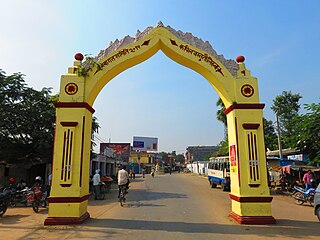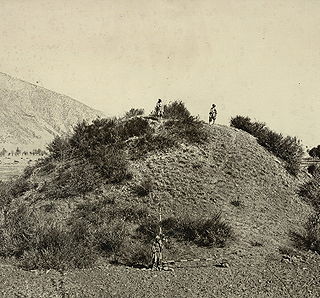Related Research Articles

Year 643 (DCXLIII) was a common year starting on Wednesday of the Julian calendar. The denomination 643 for this year has been used since the early medieval period, when the Anno Domini calendar era became the prevalent method in Europe for naming years.

Xuanzang, born Chen Hui / Chen Yi, also known by his Sanskrit Dharma name Mokṣadeva, was a 7th-century Chinese Buddhist monk, scholar, traveler, and translator. He is known for the epoch-making contributions to Chinese Buddhism, the travelogue of his journey to India in 629–645 CE, his efforts to bring over 657 Indian texts to China, and his translations of some of these texts. He was only able to translate 75 distinct sections of a total of 1335 chapters, but his translations included some of the most important Mahayana scriptures.

A blanket is a swath of soft cloth large enough either to cover or to enfold most of the user's body and thick enough to keep the body warm by trapping radiant body heat that otherwise would be lost through convection.

Songtsen Gampo, also Songzan Ganbu, was the 33rd Tibetan king and founder of the Tibetan Empire, and is traditionally credited with the introduction of Buddhism to Tibet, influenced by his Nepali consort Bhrikuti, of Nepal's Licchavi dynasty, as well as with the unification of what had previously been several Tibetan kingdoms. He is also regarded as responsible for the creation of the Tibetan script and therefore the establishment of Classical Tibetan, the language spoken in his region at the time, as the literary language of Tibet.

Kapilvastu is a municipality and administrative center of Kapilvastu District in Lumbini Province of southern Nepal. The municipality is located roughly 25 kilometres (16 mi) to the south-west of Lumbini, a UNESCO World Heritage Site and the birthplace of Gautama Buddha.
Rajapura or Rajapuram was the capital of the ancient Kamboja Kingdom mentioned in the Mahabharata. Karna led a war expedition against the Kamboja and some other tribes of the Uttarapatha a little time before the Kurukshetra war i.e. Karana Rajapuram gatva Kamboja Nirjitastvaya. The Chinese pilgrim Xuanzang who travelled to India in the 7th century refers to Hoshepulo(曷羅闍補羅, roughly hat-la-tsia-pu-la in 7th century Chinese) which has been identified as Rajapura of Sanskrit tradition by Watters and others.

Pushpagiri was an ancient Indian mahavihara or monastic complex located atop Langudi Hill in Jajpur district of Odisha, India. Pushpagiri was mentioned in the writings of the Chinese traveller Xuanzang and some other ancient sources. Until the 1990s, it was hypothesised to be one or all of the Lalitgiri-Ratnagiri-Udayagiri group of monastic sites, also located in Jajpur district. These sites contain ruins of many buildings, stupas of various sizes, sculptures, and other artifacts.

The Great Tang Records on the Western Regions is a narrative of Xuanzang's nineteen-year journey from Chang'an in central China to the Western Regions of Chinese historiography. The Buddhist scholar traveled through the Silk Road regions of what is today Xinjiang in northwest China, as well as neighboring areas in Central Asia and south China. Beyond these Chinese locations, Xuanzang also travelled around the perimeter of India, as far south as Kanchipuram. Xuanzang's travels demarcate not only an important place in cross-cultural studies of China and India, but also cross-cultural studies throughout the globe. The text is set up as both an account of Xuanzang's religious pilgrimage as well as his report of the surrounding towns and provinces of Tang China.

Tilaurakot is a neighborhood in Kapilvastu Municipality in Kapilvastu District, in the Lumbini Province of southern Nepal. Previously it was a Village development committee. At the time of the 1991 Nepal census it had a population of 5684 people living in 944 individual households. It is situated 25 kilometers (15.5 mi) northwest of the Maya Devi Temple in Lumbini, and 4.5 kilometers (2.8 mi) southeast of Nigali Sagar in Nigalihawa.

Stephen Wootton Bushell CMG MD was an English physician and amateur Orientalist who made important contributions to the study of Chinese ceramics, Chinese coins and the decipherment of the Tangut script.

Henri Cordier was a French linguist, historian, ethnographer, author, editor and Orientalist. He was President of the Société de Géographie in Paris. Cordier was a prominent figure in the development of East Asian and Central Asian scholarship in Europe in the late 19th and early 20th century. Though he had little actual knowledge of the Chinese language, Cordier had a particularly strong impact on the development of Chinese scholarship, and was a mentor of the noted French sinologist Édouard Chavannes.

Ushkur is an ancient Buddhist site near Baramulla in Jammu and Kashmir, India.
Śīlabhadra (529–645) was a Buddhist monk and philosopher. He is best known as being an abbot of Nālandā monastery in India, as being an expert on Yogācāra teachings, and for being the personal tutor of the Chinese Buddhist monk Xuanzang.
Vitashoka or Tissa was a prince of the Maurya Empire as the only full-brother of Ashoka, and the only brother left alive by Ashoka. According to Divyavadana, he was a follower of the Tirthikas and used to criticize the Buddhist monks for living a comfortable life. He was made to sit on the throne by the courtiers. When Ashoka found out about that, he persuaded Vitashoka to become a Buddhist.

Kapilavastu was an ancient city in the north of Indian subcontinent which was the capital of the clan gaṇasaṅgha or "republic" of the Shakyas in the late Iron Age, around the 6th and 5th centuries BC. King Śuddhodana and Queen Māyā are believed to have lived at Kapilavastu, as did their son Prince Siddartha Gautama until he left the palace at the age of 29.

Śalātura was the birthplace of ancient Indian Sanskrit grammarian Pāṇini who is considered to the oldest grammarian whose work has come down to modern times. In an inscription of Siladitya VII of Valabhi, he is called Śalāturiya, which means "man from Salatura". This means Pāṇini lived in Salatura of ancient Gandhara, which likely was near modern Lahor Pakistan, a small town at the junction of the Indus and Kabul Rivers, the town is located in the Swabi district of Khyber-Pakhtunkhwa, Pakistan. 20 miles northwest of the Attock Bridge.
Tardush Shad — was a Yabghu of Tokharistan. He was a son of Tong Yabgu Qaghan.

The University of ancient Taxila was an ancient higher-learning institution in Taxila, Gandhara, in present-day Punjab, Pakistan, near the bank of the Indus River. It was established as a centre of education in religious and secular topics. It started as a Vedic seat of learning; while in the early centuries CE it became a prominent centre of Buddhist scholarship as well.

Kumāralāta was an Indian founder of the Sautrāntika school of Buddhism. He was a native of Taxila, in modern day Pakistan.
Kausheya was a wild variety of ancient silk from India. Domesticated and undomesticated silk were produced in both India and China. Silk weaving is mentioned in Indian texts from the 3rd century BC. In the 4th century BC, Kātyāyana, an ancient grammarian, defined kausheva specifically as vikar, a product of kos, — in other words, silk fabric. Shatapatha Brahmana refers to kusa, a variety of silk obtained from a silkworm called kuswari or kuswara. These silkworms are raised on jujube trees.
References
- Bushell, S W. 'Thomas Watters - Obituary'. Journal of the Royal Asiatic Society (1901), republished in 'On Yuan Chwang's Travels in India (629-645 AD)'. Published 1904 and 1905, 2 vols.
- Cordier, Henri. "Thomas Watters - Necrologie". Toung Pao, Serie II, Vol II (1901), pp 92–3.
- Watters, Thomas (1904–05). On Yuan Chwang’s Travels in India. London, Royal Asiatic Society. Reprint, Delhi, Munshiram Manoharlal, 1973.